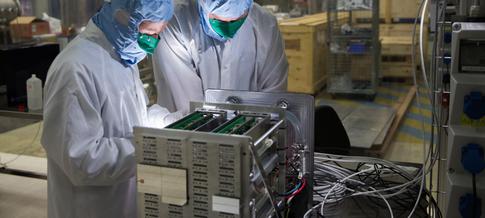XFEL: Ultrafast X-ray detector successfully tested
Ultrafast X-ray detector successfully tested
Scientists from European XFEL successfully tested the first ultrafast X-ray detector to be used for experiments at the new research facility, which is currently under construction in the Hamburg area, Germany. The new Large Pixel Detector (LPD) is intended to be used from 2017 on a scientific instrument of the X-ray facility to observe ultrafast reactions including the formation and breaking of molecular bonds. The successful test is important progress toward recording molecular movies, which will enable scientists to better understand the elementary steps of chemical processes and to contribute to the development of more efficient industrial production methods. For a molecular movie, several thousands of snapshots will be taken within fractions of seconds and later assembled.
Such snapshots of ultrafast reactions on the molecular level demand high-tech detectors: First, the detector has to deliver razor-sharp images despite the high repetition rate of the European XFEL, which is up to 27,000 X-ray flashes per second. Because the flashes are not evenly distributed but instead come in bursts in which they are extremely close to one another, the detector must be able to capture one picture every 222 nanoseconds (a nanosecond is a billionth of a second). In that way, the detector can capture a few thousand pictures per second. Secondly, the detector must yield precise results despite the large difference in intensity in a single picture —both very high and very low—that are essential in revealing the moving nanoworld. The detector just successfully passed both tests

“After six years of development at Rutherford Appleton Laboratory, the project now has passed a major milestone on our way to a large-area 1-megapixel detector. Our tests show that the detector works”, says Markus Kuster, who leads the detector group at European XFEL. “The next step will be to look for the optimal parameters for operation and to reduce the background noise.”
Despite its outstanding features, the detector that was built at Rutherford Laboratory near Oxford, U.K., does not look very spectacular: The version to be used at the European XFEL will have a surface of 0.25 square meters and will be covered with 256 sensor modules that will register the pictures. The snapshots taken will not be traditional photographs, but rather diffraction patterns, which may consist of about 1 million tiny spots of light that scientists can analyze with the help of computers.
The new detector will first be used at the Femtosecond X-Ray Experiments (FXE) instrument, which is designed to observe ultrafast reactions and molecular processes, taking advantage of the European XFEL’s unique high repetition rate. “We are excited to have the world’s first detector that is designed for recording X-ray scattering patterns from reacting molecules in solution phase”, comments Christian Bressler, Leading Scientist at European XFEL. “We now very much look forward towards the first experiments at our instrument.” For other instruments at the European XFEL—such as those built for structural determination of biomolecules, the observation of extreme states similar to those in the interior of planets, materials science, and for other applications—the detector group and its external partners are developing other highly sophisticated detectors.
